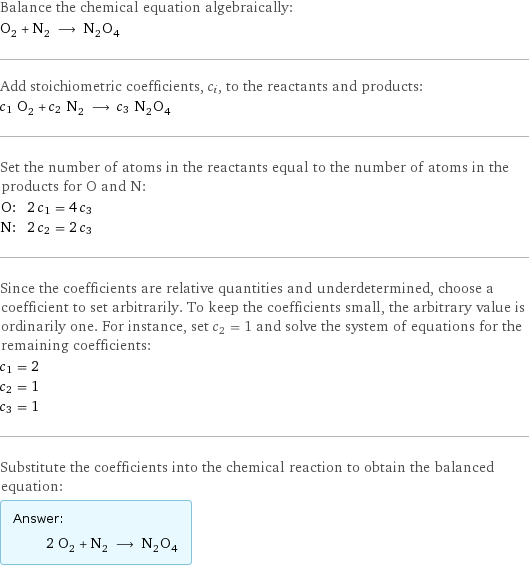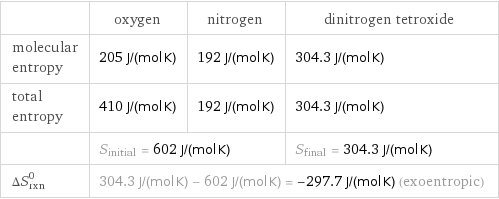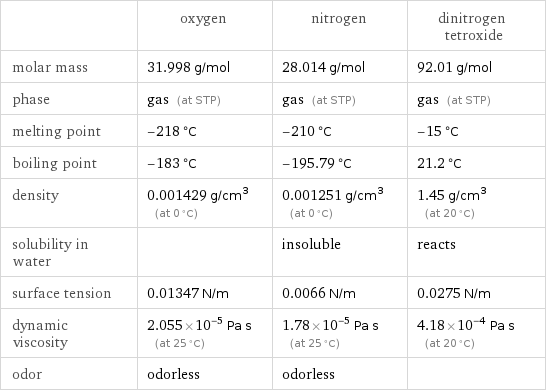Input interpretation

O_2 oxygen + N_2 nitrogen ⟶ N_2O_4 dinitrogen tetroxide
Balanced equation

Balance the chemical equation algebraically: O_2 + N_2 ⟶ N_2O_4 Add stoichiometric coefficients, c_i, to the reactants and products: c_1 O_2 + c_2 N_2 ⟶ c_3 N_2O_4 Set the number of atoms in the reactants equal to the number of atoms in the products for O and N: O: | 2 c_1 = 4 c_3 N: | 2 c_2 = 2 c_3 Since the coefficients are relative quantities and underdetermined, choose a coefficient to set arbitrarily. To keep the coefficients small, the arbitrary value is ordinarily one. For instance, set c_2 = 1 and solve the system of equations for the remaining coefficients: c_1 = 2 c_2 = 1 c_3 = 1 Substitute the coefficients into the chemical reaction to obtain the balanced equation: Answer: | | 2 O_2 + N_2 ⟶ N_2O_4
Structures

+ ⟶
Names

oxygen + nitrogen ⟶ dinitrogen tetroxide
Reaction thermodynamics
Enthalpy

| oxygen | nitrogen | dinitrogen tetroxide molecular enthalpy | 0 kJ/mol | 0 kJ/mol | 11.1 kJ/mol total enthalpy | 0 kJ/mol | 0 kJ/mol | 11.1 kJ/mol | H_initial = 0 kJ/mol | | H_final = 11.1 kJ/mol ΔH_rxn^0 | 11.1 kJ/mol - 0 kJ/mol = 11.1 kJ/mol (endothermic) | |
Gibbs free energy

| oxygen | nitrogen | dinitrogen tetroxide molecular free energy | 231.7 kJ/mol | 0 kJ/mol | 99.8 kJ/mol total free energy | 463.4 kJ/mol | 0 kJ/mol | 99.8 kJ/mol | G_initial = 463.4 kJ/mol | | G_final = 99.8 kJ/mol ΔG_rxn^0 | 99.8 kJ/mol - 463.4 kJ/mol = -363.6 kJ/mol (exergonic) | |
Entropy

| oxygen | nitrogen | dinitrogen tetroxide molecular entropy | 205 J/(mol K) | 192 J/(mol K) | 304.3 J/(mol K) total entropy | 410 J/(mol K) | 192 J/(mol K) | 304.3 J/(mol K) | S_initial = 602 J/(mol K) | | S_final = 304.3 J/(mol K) ΔS_rxn^0 | 304.3 J/(mol K) - 602 J/(mol K) = -297.7 J/(mol K) (exoentropic) | |
Equilibrium constant
![Construct the equilibrium constant, K, expression for: O_2 + N_2 ⟶ N_2O_4 Plan: • Balance the chemical equation. • Determine the stoichiometric numbers. • Assemble the activity expression for each chemical species. • Use the activity expressions to build the equilibrium constant expression. Write the balanced chemical equation: 2 O_2 + N_2 ⟶ N_2O_4 Assign stoichiometric numbers, ν_i, using the stoichiometric coefficients, c_i, from the balanced chemical equation in the following manner: ν_i = -c_i for reactants and ν_i = c_i for products: chemical species | c_i | ν_i O_2 | 2 | -2 N_2 | 1 | -1 N_2O_4 | 1 | 1 Assemble the activity expressions accounting for the state of matter and ν_i: chemical species | c_i | ν_i | activity expression O_2 | 2 | -2 | ([O2])^(-2) N_2 | 1 | -1 | ([N2])^(-1) N_2O_4 | 1 | 1 | [N2O4] The equilibrium constant symbol in the concentration basis is: K_c Mulitply the activity expressions to arrive at the K_c expression: Answer: | | K_c = ([O2])^(-2) ([N2])^(-1) [N2O4] = ([N2O4])/(([O2])^2 [N2])](../image_source/b44e1213f71eefbc23ed0b103c52b734.png)
Construct the equilibrium constant, K, expression for: O_2 + N_2 ⟶ N_2O_4 Plan: • Balance the chemical equation. • Determine the stoichiometric numbers. • Assemble the activity expression for each chemical species. • Use the activity expressions to build the equilibrium constant expression. Write the balanced chemical equation: 2 O_2 + N_2 ⟶ N_2O_4 Assign stoichiometric numbers, ν_i, using the stoichiometric coefficients, c_i, from the balanced chemical equation in the following manner: ν_i = -c_i for reactants and ν_i = c_i for products: chemical species | c_i | ν_i O_2 | 2 | -2 N_2 | 1 | -1 N_2O_4 | 1 | 1 Assemble the activity expressions accounting for the state of matter and ν_i: chemical species | c_i | ν_i | activity expression O_2 | 2 | -2 | ([O2])^(-2) N_2 | 1 | -1 | ([N2])^(-1) N_2O_4 | 1 | 1 | [N2O4] The equilibrium constant symbol in the concentration basis is: K_c Mulitply the activity expressions to arrive at the K_c expression: Answer: | | K_c = ([O2])^(-2) ([N2])^(-1) [N2O4] = ([N2O4])/(([O2])^2 [N2])
Rate of reaction
![Construct the rate of reaction expression for: O_2 + N_2 ⟶ N_2O_4 Plan: • Balance the chemical equation. • Determine the stoichiometric numbers. • Assemble the rate term for each chemical species. • Write the rate of reaction expression. Write the balanced chemical equation: 2 O_2 + N_2 ⟶ N_2O_4 Assign stoichiometric numbers, ν_i, using the stoichiometric coefficients, c_i, from the balanced chemical equation in the following manner: ν_i = -c_i for reactants and ν_i = c_i for products: chemical species | c_i | ν_i O_2 | 2 | -2 N_2 | 1 | -1 N_2O_4 | 1 | 1 The rate term for each chemical species, B_i, is 1/ν_i(Δ[B_i])/(Δt) where [B_i] is the amount concentration and t is time: chemical species | c_i | ν_i | rate term O_2 | 2 | -2 | -1/2 (Δ[O2])/(Δt) N_2 | 1 | -1 | -(Δ[N2])/(Δt) N_2O_4 | 1 | 1 | (Δ[N2O4])/(Δt) (for infinitesimal rate of change, replace Δ with d) Set the rate terms equal to each other to arrive at the rate expression: Answer: | | rate = -1/2 (Δ[O2])/(Δt) = -(Δ[N2])/(Δt) = (Δ[N2O4])/(Δt) (assuming constant volume and no accumulation of intermediates or side products)](../image_source/e5243683dfa5fb2f4d9c46da07d869ce.png)
Construct the rate of reaction expression for: O_2 + N_2 ⟶ N_2O_4 Plan: • Balance the chemical equation. • Determine the stoichiometric numbers. • Assemble the rate term for each chemical species. • Write the rate of reaction expression. Write the balanced chemical equation: 2 O_2 + N_2 ⟶ N_2O_4 Assign stoichiometric numbers, ν_i, using the stoichiometric coefficients, c_i, from the balanced chemical equation in the following manner: ν_i = -c_i for reactants and ν_i = c_i for products: chemical species | c_i | ν_i O_2 | 2 | -2 N_2 | 1 | -1 N_2O_4 | 1 | 1 The rate term for each chemical species, B_i, is 1/ν_i(Δ[B_i])/(Δt) where [B_i] is the amount concentration and t is time: chemical species | c_i | ν_i | rate term O_2 | 2 | -2 | -1/2 (Δ[O2])/(Δt) N_2 | 1 | -1 | -(Δ[N2])/(Δt) N_2O_4 | 1 | 1 | (Δ[N2O4])/(Δt) (for infinitesimal rate of change, replace Δ with d) Set the rate terms equal to each other to arrive at the rate expression: Answer: | | rate = -1/2 (Δ[O2])/(Δt) = -(Δ[N2])/(Δt) = (Δ[N2O4])/(Δt) (assuming constant volume and no accumulation of intermediates or side products)
Chemical names and formulas

| oxygen | nitrogen | dinitrogen tetroxide formula | O_2 | N_2 | N_2O_4 name | oxygen | nitrogen | dinitrogen tetroxide IUPAC name | molecular oxygen | molecular nitrogen |
Substance properties

| oxygen | nitrogen | dinitrogen tetroxide molar mass | 31.998 g/mol | 28.014 g/mol | 92.01 g/mol phase | gas (at STP) | gas (at STP) | gas (at STP) melting point | -218 °C | -210 °C | -15 °C boiling point | -183 °C | -195.79 °C | 21.2 °C density | 0.001429 g/cm^3 (at 0 °C) | 0.001251 g/cm^3 (at 0 °C) | 1.45 g/cm^3 (at 20 °C) solubility in water | | insoluble | reacts surface tension | 0.01347 N/m | 0.0066 N/m | 0.0275 N/m dynamic viscosity | 2.055×10^-5 Pa s (at 25 °C) | 1.78×10^-5 Pa s (at 25 °C) | 4.18×10^-4 Pa s (at 20 °C) odor | odorless | odorless |
Units
